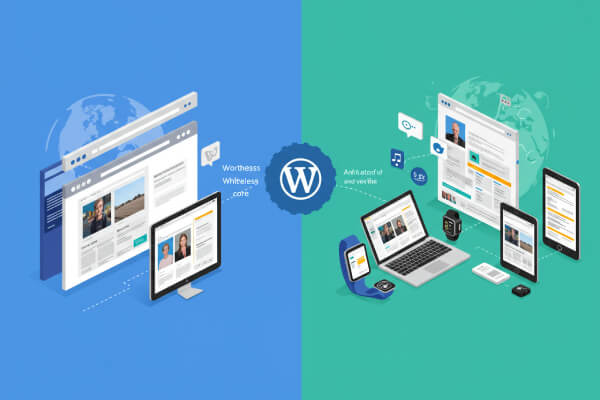
What is a Headless CMS and Why Should You Choose WordPress with Next.js?
In today’s digital-first world, speed, flexibility, and scalability have become non-negotiable aspects of modern website development. Businesses—especially NGOs and eCommerce platforms—need websites that not only load fast but are secure, scalable, and future-proof. This is where a headless CMS architecture comes into play, and one of the most powerful combinations today is using WordPress with Next.js.
In this blog, we’ll explain what a headless CMS is, why decoupling your WordPress backend is a smart move, and how Next.js can supercharge your site’s performance. If you’re planning to convert WordPress to React or exploring how to improve loading time of your website, this post is your essential guide.
What is a Headless CMS?
A headless CMS is a content management system where the “head” (the frontend or presentation layer) is separated from the “body” (the backend content repository). Unlike traditional CMS platforms where the frontend and backend are tightly coupled, a headless CMS allows you to manage content in one place and deliver it anywhere via APIs.
Key Features of a Headless CMS:
- Content Delivery via API (e.g., REST or GraphQL)
- Flexibility in Frontend Frameworks (React, Vue, Angular)
- Scalability and Speed
Omnichannel Publishing (web, mobile, IoT, etc.)
Why Use WordPress as a Headless CMS?
WordPress powers over 40% of websites globally and is known for its user-friendly admin interface. But the traditional WordPress setup can struggle with performance, especially for large-scale or dynamic sites.
By using WordPress REST API, you can convert your WordPress site into a headless CMS. This means you keep WordPress as your backend for managing posts, pages, and media, while the frontend is built using a modern JavaScript framework like Next.js.
Benefits of Using WordPress in a Headless Setup:
- Better Performance
Traditional WordPress themes load everything through PHP, which can slow down load times. When decoupled, the frontend becomes lighter and faster, especially when using Next.js for server-side rendering (SSR) or static site generation (SSG). - Improved Website Security
A headless architecture reduces exposure to common WordPress vulnerabilities. Since the WordPress admin panel is not directly connected to the frontend, your public-facing site becomes significantly harder to attack. This aligns with popular WordPress security tips and helps build a secure website architecture. - More Flexibility with Frontend Design
Frontend developers can use modern tools like React and Tailwind CSS, offering much more control and customization than traditional PHP-based WordPress themes.
Scalability
Whether you’re running an eCommerce site with WordPress or a donation platform for NGOs, the decoupled architecture ensures that your frontend can scale independently of your backend.
What is Next.js and Why Use It?
Next.js is a powerful React framework that allows you to build blazing-fast websites and applications with ease. It supports server-side rendering, static site generation, API routes, and image optimization out of the box.
When paired with WordPress, Next.js pulls content via the WordPress REST API, renders it on the frontend, and delivers a lightning-fast user experience.
Key Benefits of Next.js:
- Lightning-Fast Load Times: Thanks to features like static generation and image optimization, Next.js drastically improves loading time of your website.
- SEO Optimization: With server-side rendering, pages are fully rendered before they reach the browser, which is ideal for SEO. This means better rankings on Google and improved visibility for your content.
- Built-in Routing & Code Splitting: Automatically splits your code by page, loading only what’s necessary and reducing the overall load on users’ browsers.
Enhanced Developer Experience: Easy integrations, automatic refreshes, and extensive documentation make building and maintaining sites simpler.
How WordPress + Next.js Work Together
Here’s a simple breakdown of how the architecture functions:
- Content Management: You or your team continue to use the WordPress dashboard to create and manage content.
- Data Fetching: Next.js fetches content from WordPress via the WordPress REST API.
- Frontend Rendering: Next.js handles rendering the data into beautiful React components.
- User Experience: Visitors enjoy a fast, secure, and responsive website.
Whether you’re looking to convert WordPress to Next.js or simply want to improve WordPress website loading time, this combination delivers on all fronts.
Who Should Use Headless WordPress with Next.js?
This tech stack is ideal for:
- NGOs & Nonprofits: Improve performance and donation conversion with a clean, fast-loading site.
- eCommerce Brands: Deliver dynamic product pages quickly and securely.
- Content Publishers: Push content to multiple platforms from a single WordPress backend.
Developers: Enjoy the flexibility of React while maintaining client-friendly WordPress admin panels.
Challenges to Consider
While the benefits are clear, a few considerations are necessary:
- Initial Setup Complexity: Connecting WordPress and Next.js requires some technical know-how.
- Plugin Compatibility: Some traditional WordPress plugins may not work out-of-the-box.
- Hosting: You’ll need to host the frontend and backend separately or use platforms like Vercel for frontend deployment.
However, with the right development partner or agency, these hurdles can be easily overcome.
Final Thoughts
Switching to a headless CMS setup using WordPress with Next.js can revolutionize your website’s speed, security, and scalability. This approach brings together the best of both worlds—WordPress’s intuitive backend and React’s modern frontend capabilities.
Whether you’re an NGO looking to increase engagement or an eCommerce business aiming to boost conversions, the WordPress + Next.js combination is a future-proof solution. It not only aligns with current WordPress security tips and performance best practices but also gives your team the tools to thrive in a competitive digital environment.
Ready to Convert WordPress to React or Next.js?
If you’re thinking about making the switch and want expert guidance, get in touch with our team. At Munivar Technologies, we specialize in building secure, high-performance websites using headless CMS architecture. Let’s future-proof your website today.






